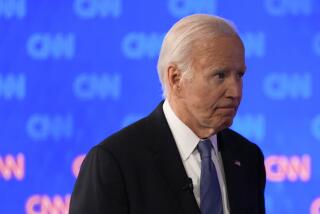High Court Examines Scope of Child Porn Law
The Supreme Court justices, hearing arguments on the reach of expanded child pornography laws, wondered Tuesday whether they may have committed a crime by renting Hollywood movies such as “Traffic” or “Titanic.”
At issue was a 1996 law that made it a crime to sell or possess “any visual depiction” that “appears” to show “simulated” sex involving actors who may be minors.
Congress, wanting to stamp out the scourge of child pornography, chose to outlaw even “computer generated images” that portray minors in apparent sex scenes. But several justices worried that the law as written may have gone too far.
Justice Sandra Day O’Connor said the Oscar-winning film “Traffic” could fall victim to the law’s broad definition of illegal pornography. One scene portrays the daughter of an official in the war on drugs apparently having sex with a drug dealer.
Oddly enough, movie-makers are not in danger, O’Connor noted, as long as they can show that their young-looking actors are at least 18. But there is no similar defense for those who buy or rent such films, she said.
Justice Stephen G. Breyer, picking up the hypothetical concern, said that the law seems to call for prosecutions for films with simulated sex scenes involving young actors.
“If I buy ‘Traffic,’ ‘Lolita’ and ‘Titanic,’ why am I not guilty of the federal crime of possessing child pornography?” Breyer asked.
Because the government would not bring such a case, replied deputy U.S. Solicitor Gen. Paul D. Clement, defending the law. “We’re not prosecuting people who pick up ‘Traffic’ at Blockbuster,” he said.
But that answer did not fully resolve the question. When limits on free speech are at issue, federal judges typically examine a law’s potential reach, not just how it is being used in actual cases.
Two years ago, the U.S. 9th Circuit Court of Appeals struck down part of the expanded child pornography law because it reached so-called “virtual pornography.”
Although the government can protect children by banning all child pornography that involves real children, it cannot outlaw “the generation of images of fictitious children engaged in imaginary but explicit sexual conduct,” Judge Donald Molloy wrote for the appeals court.
In the past, the Supreme Court has said child pornography, like obscenity, deserves no free-speech protection under the 1st Amendment. This is so, the court said in 1982, because children are inevitably abused in the making of child pornography.
But the 9th Circuit reasoned that the government was not free to prosecute people for making or possessing drawings or computer images, since no actual children were harmed.
The expanded anti-pornography law had been challenged in San Francisco by the Free Speech Coalition, a group of adult-oriented businesses and artists who feared they could face prosecution under the broadly worded measure.
The Supreme Court took up the government’s appeal and, despite the tenor of Tuesday’s questioning, the justices are likely to uphold the law. They hinted, however, that they may need to narrow the law’s scope in order to preserve it.
Chief Justice William H. Rehnquist commented that the court could write an opinion that focuses the law on child smut and prevents its use “out on the fringe.”
The law also had one unabashed champion Tuesday in Justice Antonin Scalia. When Louis Sirkin, attorney for the Free Speech Coalition, rose to speak, Scalia cut him off after a few seconds.
“What great works of Western art would be taken away from us,” Scalia snapped, “if we were unable to show minors copulating?”
Justice John Paul Stevens interrupted to cite Shakespeare’s “Romeo and Juliet” as a great work of art that involves youthful romance.
“You’ve seen a different version of that than I have!” Scalia told Stevens.
At another point in the argument, Scalia said he had not seen the three films--”Traffic,” “Lolita” and “Titanic”--being discussed by his colleagues. “I don’t know what is meant by simulated sex,” Scalia said. He pointed to other sections of the law that define child pornography as being more explicit, such as showing sexual intercourse.
Stevens said the law clearly refers to “simulated” sex. That would include a scene of “a couple under a blanket,” he said.
Scalia disagreed. “It has to be more explicit, with nudity,” he said.
While the two did not resolve their dispute during the argument, the justices have weeks to write an opinion in the case, known as Ashcroft vs. Free Speech Coalition, 00-795.
The justices also took up a key question involving the future of the “sexual predator” laws in California and 16 other states. Under these 1990s-era measures, more than 1,200 men who have served their prison sentences for sex crimes remain locked up in state facilities. They supposedly are undergoing mental health treatment, but their confinement is indefinite. In reality, it resembles indefinite imprisonment, their lawyers say.
Last year, the Kansas Supreme Court ruled that this post-prison confinement is unconstitutional unless prosecutors can show that these sex offenders are “unable to control” their behavior.
Kansas Atty. Gen. Carla Stovall told the justices that standard is nearly impossible to meet. If adopted as a constitutional rule, it could force the states to release many of its most dangerous sex criminals.
For their part, the justices sounded closely split in the case of Kansas vs. Crane, 00-957. Although they agreed that the states must confine dangerous sex criminals, several of them said they were concerned about using forced “treatment” as the means to do it.
More to Read
Get the L.A. Times Politics newsletter
Deeply reported insights into legislation, politics and policy from Sacramento, Washington and beyond. In your inbox three times per week.
You may occasionally receive promotional content from the Los Angeles Times.







